Overview
- Brief Narrative
- Sketch of an imaginary aerial battle done by Fritz Vendig, 12, when he was living as a refugee from Nazi Germany in Maur, Switzerland, with his parents, Ernst and Charlotte, and younger brother Heiner. In the mid-1930s, Ernst's business was taken from him when it was Aryanized, or cleansed of Jews. In November 1938, Ernst was arrested during Kristallnacht. After his release, they prepared to leave. On May 13, 1939, the family, along with Ernst's mother Pauline, sailed for Cuba on the MS St. Louis. Cuban authorities refused entry to nearly all passengers. Appeals were made to the Cuban and US governments, but the ship had to return to Europe. The family was given refuge in Belgium. In May 1940, Germany occupied Belgium and Ernst was deported to France and imprisoned in St. Cyprien and then Gurs internment camps. In 1941, Charlotte, the boys, and Pauline obtained false papers and illegally entered France to be near Ernst. In August 1942, they were all interned at Les Milles and then Rivesaltes, until Charlotte's sister in Switzerland managed to get them out of the camp and smuggled into Zurich. The war ended in May 1945 with Germany's surrender. Fritz (later Fred) and his family emigrated to the United States in 1946.
- Artwork Title
- Krieg Saust Durchs Land, 1944
- Alternate Title
- War Rushes Through the Land
- Date
-
creation:
1944
- Geography
-
creation:
Maur (Switzerland)
- Credit Line
- United States Holocaust Memorial Museum Collection, Gift of Stephanie Vendig
- Signature
- back, bottom, pencil : F. Vendig
- Contributor
-
Artist:
Ernst Vendig
Subject: Ernst Vendig
- Biography
-
Ernst Vendig was born in 1899 in Kauserlautern, Germany. He lived with his wife Charlotte in Kauserlautern where Ernst ran a haberdashery. They had a son, Fritz, in 1932. As soon as the Nazi regime took power in Germany in 1933, it pursued policies to exclude Jews from German society. Ernst's business was Aryanized, or cleansed of Jews, in the mid-thirties, and taken from him. The family, now including Heiner, born in 1937, moved to Berlin. In November 9-10, 1938, Ernst was arrested during the Kristallnacht pogrom. After his release, the family made arrangements to leave Germany. On May 13, 1939, Ernst, Charlotte, the two boys, and Ernst's mother Pauline sailed for Cuba on the Ms St. Louis. Cuban authorities refused entry to nearly all the passengers. Appeals were made to the Cuban and US governments, but the ship had to return to Europe. The family was given refuge in Belgium. In May 1940, Germany occupied Belgium. Ernst was deported to France and imprisoned in St. Cyprien and then Gurs internment camps. In 1941, Charlotte, the boys, and Pauline obtained false papers and illegally entered France to be near Ernst. In August 1942, they were all interned at Les Milles and then Rivesaltes camp, until Charlotte's sister in Switzerland managed to get them out of the camp and smuggled into Zurich. The war ended in May 1945 with Germany's surrender. Ernst and his family emigrated to the United States in 1946.
Physical Details
- Language
- German
- Classification
-
Art
- Category
-
Children's art
- Object Type
-
Children's drawings (lcsh)
- Physical Description
- Child’s crudely drawn pencil sketch of an imagined aerial battle. At the top, a plane on the left shoots at a plane on the right. A figure parachutes below the left plane. Below this is a semi-circular structure, perhaps a bunker. To the left is a long barreled cannon. In the center is a tiny falling plane. To the right is an oval shaped bomb with fins, plunging down above a plane, propellers aiming upward. Another plane dives down from the right towards the rising one. Near the bottom is an explosion, with dark lines extending in different directions. At the bottom center is an indistinctly outlined cityscape. It is signed and dated.
- Dimensions
- overall: Height: 6.875 inches (17.463 cm) | Width: 8.625 inches (21.908 cm)
- Materials
- overall : paper, graphite
- Inscription
- back, top right, pencil : Tounerge(?) 1944
back, center, pencil : I Krieg / Krieg, saust durchs Land, / Die Welt liegt verbannt. / In manchen Nächten, / Ein Licht, blitzt auf, / Und bald liegt in Trümmemn ein Haus [1 War, War, rushes through the land, in some nights, a light flashes on, and soon a house lies in ruins]
II Die Obdachlosen, sie irren umher, / Wo is ihr Haus ,ja in der Erd’. / Noch lang werden sie suchen / Bis ein neu Heim erscheint, / Dann ist das Böse vom Alten längst / verweint. [2 The homeless wander, Where is there house “yes it is in the Earth”. Still they will be searching for a new home to appear, that is the long weeping Evil from old.]
Rights & Restrictions
- Conditions on Access
- No restrictions on access
- Conditions on Use
- Restrictions on use
Keywords & Subjects
- Topical Term
- Concentration camp inmates as artists--France--Gurs. Hidden children (Holocaust)--France--Biography. Holocaust survivors--United States--Biography. Holocaust, Jewish (1939-1945)--France--Personal narratives, Jewish. Jewish children in the Holocaust--Switzerland--Biography. Jewish refugees--Switzerland--Biography. World War, 1939-1945--Prisoners and prisons, French. World War, 1939-1945--Refugees--Switzerland--Personal narratives, Jewish.
- Corporate Name
- St. Louis (Ship)
Administrative Notes
- Legal Status
- Permanent Collection
- Provenance
- The drawing was donated to the United States Holocaust Memorial Museum in 2013 by Stephanie Vendig, wife of Fred Vendig.
- Funding Note
- The cataloging of this artifact has been supported by a grant from the Conference on Jewish Material Claims Against Germany.
- Record last modified:
- 2023-06-02 09:15:40
- This page:
- https://collections.ushmm.org/search/catalog/irn526454
Download & Licensing
In-Person Research
- By Appointment
- Request 21 Days in Advance of Visit
- Plan a Research Visit
- Request to See This Object
Contact Us
Also in Fred Vendig family collection
The collection consists of wartime drawings, a pocket calendar, correspondence, papers, photographs, and printed materials relating to the experiences of Ernst and Charlotte Vendig, their sons Fritz (Fred) and Heiner (Henry) and their family before and during the Holocaust in Germany, during their unsuccessful 1939 voyage on the M.S. St. Louis, their internment in French detention camps and escape to Switzerland, and their emigration to the United States after the war.
Date: 1859-2002
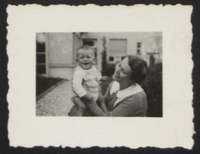
Fred Vendig papers
Document
The Fred Vendig papers includes biographical materials, a pocket calendar, correspondence, immigration papers, personal narratives, photographs, and printed materials documenting the Vendig family’s expropriation by the Nazi government, 1939 voyage aboard the M.S. St. Louis, refuge in Belgium, internment in French concentration camps, refuge in Switzerland, and immigration to the United States. Biographical materials include birth, marriage, and death certificates; identification papers; and student, citizenship, refugee, and camp papers. The records trace the Vendig family’s precarious citizenship, refugee, internee, and immigrant status through Germany, Belgium, France, and Switzerland, their release from Rivesaltes, and their immigration to the United States. The collection further includes materials documenting Fred Vendig’s uncle, Fritz Vendig, who was killed at Verdun during World War I, and his grandfather, David Vendig, who died in 1930. The 1939 pocket calendar was used by Charlotte Vendig as an address book, birthday calendar, account record, notebook, and diary, with a few entries through 1959. Correspondence files include photocopies of letters Charlotte Vendig wrote aboard the M.S. St. Louis to her family and original letters she wrote to her family from Aix-en-Provence and Bex; letters Ernst Vendig wrote to his family from internment camps St. Cyprien and Gurs; illustrated notes from Fred Vendig to his family; postcards documenting Ernst and Pauline Vendig’s registration for reparations; and correspondence between Ernst Vendig and Captain Gustav Schröder after the war. Immigration papers include correspondence and affidavits documenting the Vendig family’s efforts to immigrate to the United States. Personal narratives include English and German versions of Charlotte Vendig’s Holocaust experiences. She describes antisemitism under the Nazis, losing the family business, unsuccessful emigration to Cuba aboard the M.S. St. Louis, refugee life in Belgium and France, internment in Les Milles and Rivesaltes, release, and refuge in Switzerland. Photographic materials include four photo albums and eighty eight loose photographs depicting the Vendig family and their journey aboard the M.S. St. Louis. The albums include photographs of Ernst and Charlotte Vendig’s families, prewar life in Germany and on vacation, childhood photographs of Fred and Henry Vendig, and the family’s journey aboard M.S. St. Louis. Loose photographs depict Ernst and Charlotte Vendig’s families, the Vendigs aboard the M.S. St. Louis, fellow passengers after they disembarked in Belgium, Henry Vendig in Brussels, and the Foreign Labor Battalion (GTE) camp in Aubagne. Printed materials primarily consist of clippings from German and Swiss newspapers from the 1930s and 1940s and include articles written by Ernst Vendig describing the refugee experience. This series also includes brochures and a history describing the town of Hachenburg as well as a prayer book printed in 1859.
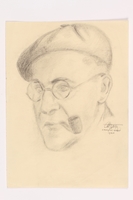
Portrait of a pipe smoking man interned at Gurs drawn by another inmate
Object
Pencil portrait of his father Ernst with pipe and beret owned by Fred Vendig. It was done by an unknown inmate when Ernst was imprisoned at Gurs internment camp in France in 1940. A few years after the Nazi dictatorship took power in Germany in 1933, Ernst's business was taken from him when it was Aryanized, or cleansed of Jews. In November 1938, Ernst was arrested during Kristallnacht. On May 13, 1939, Ernst, wife Charlotte, and sons Fritz, 7, and Heiner, 2, and his mother Pauline sailed for Cuba on the MS St. Louis. Cuban authorities refused entry to nearly all passengers. Appeals were made to the Cuban and US governments, but the ship had to return to Europe. The family was given refuge in Belgium. In May 1940, Germany occupied Belgium and Ernst was deported to France and imprisoned in St. Cyprien and then Gurs. In 1941, Charlotte, the boys, and Pauline obtained false papers and illegally entered France to be near Ernst. In August 1942, they were all interned at Les Milles and then Rivesaltes, until Charlotte's sister in Switzerland got them smuggled into Zurich. The war ended in May 1945 with Germany's surrender. The family emigrated to the United States in 1946.
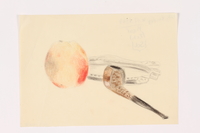
German Jewish refugee child's still life of an apple, ashtray, and a smoking pipe
Object
Colored pencil still life drawn by 12 year old Fritz Vendig when he was living as a refugee from Nazi Germany in Maur, Switzerland, with his parents, Ernst and Charlotte, and younger brother Heiner. In the mid-1930s, Fritz's father's business was taken from him when it was Aryanized, or cleansed of Jews. In November 1938, Ernst was arrested during Kristallnacht. After his release, the family prepared to leave. On May 13, 1939, Fritz, 7, his parents Ernst and Charlotte, his brother Heiner, 2, and his paternal grandmother Pauline, sailed for Cuba on the MS St. Louis. Cuban authorities refused entry to nearly all passengers. Appeals were made to the Cuban and US governments, but the ship had to return to Europe. The family was given refuge in Belgium. In May 1940, Germany occupied Belgium and Ernst was deported to France and imprisoned in St. Cyprien and then Gurs internment camps. In 1941, Charlotte, the boys, and Pauline obtained false papers and illegally entered France to be near Ernst. In August 1942, they were all interned at Les Milles and then Rivesaltes, until Charlotte's sister in Switzerland managed to get them out of the camp and smuggled into Zurich. The war ended in May 1945 with Germany's surrender. Fritz (later Fred) and his family emigrated to the United States in 1946.
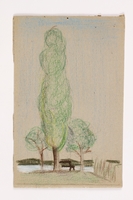
Child's drawing of trees along the lake done by a German Jewish refugee
Object
Colored pencil drawing of the lake by 13 year old Fritz Vendig when he was living as a refugee from Nazi Germany in Maur, Switzerland, with his parents, Ernst and Charlotte, and younger brother Heiner. In the mid-1930s, Fritz's father's business was taken from him when it was Aryanized, or cleansed of Jews. In November 1938, Ernst was arrested during Kristallnacht. After his release, the family prepared to leave. On May 13, 1939, Fritz, 7, his parents Ernst and Charlotte, his brother Heiner, 2, and his paternal grandmother Pauline, sailed for Cuba on the MS St. Louis. Cuban authorities refused entry to nearly all passengers. Appeals were made to the Cuban and US governments, but the ship had to return to Europe. The family was given refuge in Belgium. In May 1940, Germany occupied Belgium and Ernst was deported to France and imprisoned in St. Cyprien and then Gurs internment camps. In 1941, Charlotte, the boys, and Pauline obtained false papers and illegally entered France to be near Ernst. In August 1942, they were all interned at Les Milles and then Rivesaltes, until Charlotte's sister in Switzerland managed to get them out of the camp and smuggled into Zurich. The war ended in May 1945 with Germany's surrender. Fritz (later Fred) and his family emigrated to the United States in 1946.
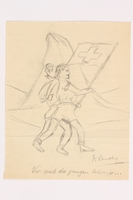
Child's sketch of 2 boys parading with a Swiss flag by a German Jewish refugee
Object
Sketch of two boys marching with a flag drawn by 13 year old Fritz Vendig when he was living as a refugee from Nazi Germany in Maur, Switzerland, with his parents, Ernst and Charlotte, and younger brother Heiner. In the mid-1930s, Fritz's father's business was taken from him when it was Aryanized, or cleansed of Jews. In November 1938, Ernst was arrested during Kristallnacht. After his release, the family prepared to leave. On May 13, 1939, Fritz, 7, his parents Ernst and Charlotte, his brother Heiner, 2, and his paternal grandmother Pauline, sailed for Cuba on the MS St. Louis. Cuban authorities refused entry to nearly all passengers. Appeals were made to the Cuban and US governments, but the ship had to return to Europe. The family was given refuge in Belgium. In May 1940, Germany occupied Belgium and Ernst was deported to France and imprisoned in St. Cyprien and then Gurs internment camps. In 1941, Charlotte, the boys, and Pauline obtained false papers and illegally entered France to be near Ernst. In August 1942, they were all interned at Les Milles and then Rivesaltes, until Charlotte's sister in Switzerland managed to get them out of the camp and smuggled into Zurich. The war ended in May 1945 with Germany's surrender. Fritz (later Fred) and his family emigrated to the United States in 1946.
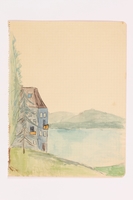
Child's watercolor of a house near a lake in the Alps by a German Jewish refugee
Object
Colored pencil drawing of a lakeside house drawn by 12 year old Fritz Vendig when he was living as a refugee from Nazi Germany in Maur, Switzerland, with his parents, Ernst and Charlotte, and younger brother Heiner. In the mid-1930s, Fritz's father's business was taken from him when it was Aryanized, or cleansed of Jews. In November 1938, Ernst was arrested during Kristallnacht. After his release, the family prepared to leave. On May 13, 1939, Fritz, 7, his parents Ernst and Charlotte, his brother Heiner, 2, and his paternal grandmother Pauline, sailed for Cuba on the MS St. Louis. Cuban authorities refused entry to nearly all passengers. Appeals were made to the Cuban and US governments, but the ship had to return to Europe. The family was given refuge in Belgium. In May 1940, Germany occupied Belgium and Ernst was deported to France and imprisoned in St. Cyprien and then Gurs internment camps. In 1941, Charlotte, the boys, and Pauline obtained false papers and illegally entered France to be near Ernst. In August 1942, they were all interned at Les Milles and then Rivesaltes, until Charlotte's sister in Switzerland managed to get them out of the camp and smuggled into Zurich. The war ended in May 1945 with Germany's surrender. Fritz (later Fred) and his family emigrated to the United States in 1946.
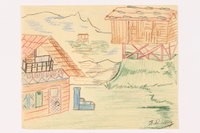
Child's drawing of 2 houses near the mountains by a German Jewish refugee
Object
Colored pencil drawing of two cottages in the mountains drawn by 12 year old Fritz Vendig when he was living as a refugee from Nazi Germany in Maur, Switzerland, with his parents, Ernst and Charlotte, and younger brother Heiner. In the mid-1930s, Fritz's father's business was taken from him when it was Aryanized, or cleansed of Jews. In November 1938, Ernst was arrested during Kristallnacht. After his release, the family prepared to leave. On May 13, 1939, Fritz, 7, his parents Ernst and Charlotte, his brother Heiner, 2, and his paternal grandmother Pauline, sailed for Cuba on the MS St. Louis. Cuban authorities refused entry to nearly all passengers. Appeals were made to the Cuban and US governments, but the ship had to return to Europe. The family was given refuge in Belgium. In May 1940, Germany occupied Belgium and Ernst was deported to France and imprisoned in St. Cyprien and then Gurs internment camps. In 1941, Charlotte, the boys, and Pauline obtained false papers and illegally entered France to be near Ernst. In August 1942, they were all interned at Les Milles and then Rivesaltes, until Charlotte's sister in Switzerland managed to get them out of the camp and smuggled into Zurich. The war ended in May 1945 with Germany's surrender. Fritz (later Fred) and his family emigrated to the United States in 1946.
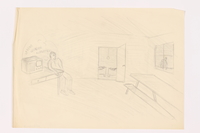
Child's sketch of a man listening to a radio drawn by a young German Jewish refugee
Object
Sketch of a man listening to a radio, perhaps in a barrack, drawn Fritz Vendig, 12, when he was living as a refugee from Nazi Germany in Maur, Switzerland, with his parents, Ernst and Charlotte, and younger brother Heiner. In the mid-1930s, Fritz's father's business was taken from him when it was Aryanized, or cleansed of Jews. In November 1938, Ernst was arrested during Kristallnacht. After his release, the family prepared to leave. On May 13, 1939, Fritz, 7, his parents Ernst and Charlotte, his brother Heiner, 2, and his paternal grandmother Pauline, sailed for Cuba on the MS St. Louis. Cuban authorities refused entry to nearly all passengers. Appeals were made to the Cuban and US governments, but the ship had to return to Europe. The family was given refuge in Belgium. In May 1940, Germany occupied Belgium and Ernst was deported to France and imprisoned in St. Cyprien and then Gurs internment camps. In 1941, Charlotte, the boys, and Pauline obtained false papers and illegally entered France to be near Ernst. In August 1942, they were all interned at Les Milles and then Rivesaltes, until Charlotte's sister in Switzerland managed to get them out of the camp and smuggled into Zurich. The war ended in May 1945 with Germany's surrender. Fritz (later Fred) and his family emigrated to the United States in 1946.
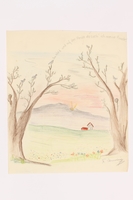
Child's drawing of a faraway house by a German Jewish refugee
Object
Colored pencil drawing of an imaginary landscape done by Fritz Vendig, 12, when he was living as a refugee from Nazi Germany in Maur, Switzerland, with his parents, Ernst and Charlotte, and younger brother Heiner. In the mid-1930s, Ernst's business was taken from him when it was Aryanized, or cleansed of Jews. In November 1938, Ernst was arrested during Kristallnacht. After his release, they prepared to leave. On May 13, 1939, the family, along with Ernst's mother Pauline, sailed for Cuba on the MS St. Louis. Cuban authorities refused entry to nearly all passengers. Appeals were made to the Cuban and US governments, but the ship had to return to Europe. The family was given refuge in Belgium. In May 1940, Germany occupied Belgium and Ernst was deported to France and imprisoned in St. Cyprien and then Gurs internment camps. In 1941, Charlotte, the boys, and Pauline obtained false papers and illegally entered France to be near Ernst. In August 1942, they were all interned at Les Milles and then Rivesaltes, until Charlotte's sister in Switzerland managed to get them out of the camp and smuggled into Zurich. The war ended in May 1945 with Germany's surrender. Fritz (later Fred) and his family emigrated to the United States in 1946.
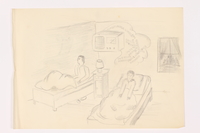
Child’s pencil sketch of 2 boys in beds listening to the radio by a German Jewish refugee
Object
Sketch of two boys, possibly Fritz and his brother Heiner, listening to radio reports by Fritz Vendig, 12, when he was living as a refugee from Nazi Germany in Maur, Switzerland, with his parents, Ernst and Charlotte, and younger brother Heiner. In the mid-1930s, Ernst's business was taken from him when it was Aryanized, or cleansed of Jews. In November 1938, Ernst was arrested during Kristallnacht. After his release, they prepared to leave. On May 13, 1939, the family, along with Ernst's mother Pauline, sailed for Cuba on the MS St. Louis. Cuban authorities refused entry to nearly all passengers. Appeals were made to the Cuban and US governments, but the ship had to return to Europe. The family was given refuge in Belgium. In May 1940, Germany occupied Belgium and Ernst was deported to France and imprisoned in St. Cyprien and then Gurs internment camps. In 1941, Charlotte, the boys, and Pauline obtained false papers and illegally entered France to be near Ernst. In August 1942, they were all interned at Les Milles and then Rivesaltes, until Charlotte's sister in Switzerland managed to get them out of the camp and smuggled into Zurich. The war ended in May 1945 with Germany's surrender. Fritz (later Fred) and his family emigrated to the United States in 1946.
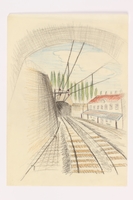
Child’s drawing of train tracks approaching a tunnel by a German Jewish refugee
Object
Colored pencil drawing of a train going into a tunnel by Fritz Vendig, 12, when he was living as a refugee from Nazi Germany in Maur, Switzerland, with his parents, Ernst and Charlotte, and younger brother Heiner. In the mid-1930s, Ernst's business was taken from him when it was Aryanized, or cleansed of Jews. In November 1938, Ernst was arrested during Kristallnacht. After his release, they prepared to leave. On May 13, 1939, the family, along with Ernst's mother Pauline, sailed for Cuba on the MS St. Louis. Cuban authorities refused entry to nearly all passengers. Appeals were made to the Cuban and US governments, but the ship had to return to Europe. The family was given refuge in Belgium. In May 1940, Germany occupied Belgium and Ernst was deported to France and imprisoned in St. Cyprien and then Gurs internment camps. In 1941, Charlotte, the boys, and Pauline obtained false papers and illegally entered France to be near Ernst. In August 1942, they were all interned at Les Milles and then Rivesaltes, until Charlotte's sister in Switzerland managed to get them out of the camp and smuggled into Zurich. The war ended in May 1945 with Germany's surrender. Fritz (later Fred) and his family emigrated to the United States in 1946.
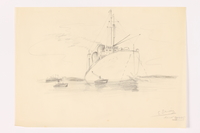
Child's drawing of a large ocean liner by a German Jewish refugee
Object
Drawing of a ship entering port done by Fritz Vendig, 12, while living as a refugee from Nazi Germany in Maur, Switzerland, with his parents, Ernst and Charlotte, younger brother Heiner, and paternal grandmother Pauline. In the mid-1930s, Fritz's father's business was taken from him when it was Aryanized, or cleansed of Jews. In November 1938, Ernst was arrested during Kristallnacht. After his release, the family prepared to leave. On May 13, 1939, Fritz, 7, his parents Ernst and Charlotte, his brother Heiner, 2, and his paternal grandmother Pauline, sailed for Cuba on the MS St. Louis. Cuban authorities refused entry to nearly all passengers. Appeals were made to the Cuban and US governments, but the ship had to return to Europe. The family was given refuge in Belgium. In May 1940, Germany occupied Belgium and Ernst was deported to France and imprisoned in St. Cyprien and then Gurs internment camps. In 1941, Charlotte, the boys, and Pauline obtained false papers and illegally entered France to be near Ernst. In August 1942, they were all interned at Les Milles and then Rivesaltes, until Charlotte's sister in Switzerland managed to get them out of the camp and smuggled into Zurich. The war ended in May 1945 with Germany's surrender. Fritz (later Fred) and his family emigrated to the United States in 1946.
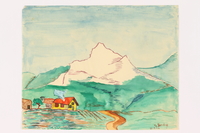
Child's watercolor of a house near a road leading to the Alps by a young Jewish boy
Object
Drawing of hillside cottages by Fritz Vendig, 12, when he was living as a refugee from Nazi Germany in Maur, Switzerland, with his parents, Ernst and Charlotte, and younger brother Heiner. In the mid-1930s, Ernst's business was taken from him when it was Aryanized, or cleansed of Jews. In November 1938, Ernst was arrested during Kristallnacht. After his release, they prepared to leave. On May 13, 1939, the family, along with Ernst's mother Pauline, sailed for Cuba on the MS St. Louis. Cuban authorities refused entry to nearly all passengers. Appeals were made to the Cuban and US governments, but the ship had to return to Europe. The family was given refuge in Belgium. In May 1940, Germany occupied Belgium and Ernst was deported to France and imprisoned in St. Cyprien and then Gurs internment camps. In 1941, Charlotte, the boys, and Pauline obtained false papers and illegally entered France to be near Ernst. In August 1942, they were all interned at Les Milles and then Rivesaltes, until Charlotte's sister in Switzerland managed to get them out of the camp and smuggled into Zurich. The war ended in May 1945 with Germany's surrender. Fritz (later Fred) and his family emigrated to the United States in 1946.
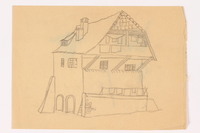
Child's two sided drawing of a house and 4 watercolor studies by a German Jewish refugee
Object
Douber sided watercolor with a house on side and 4 small drawings on the other, done by Fritz Vendig, 12, when he was living as a refugee from Nazi Germany in Maur, Switzerland, with his parents, Ernst and Charlotte, and younger brother Heiner. In the mid-1930s, Ernst's business was taken from him when it was Aryanized, or cleansed of Jews. In November 1938, Ernst was arrested during Kristallnacht. After his release, they prepared to leave. On May 13, 1939, the family, along with Ernst's mother Pauline, sailed for Cuba on the MS St. Louis. Cuban authorities refused entry to nearly all passengers. Appeals were made to the Cuban and US governments, but the ship had to return to Europe. The family was given refuge in Belgium. In May 1940, Germany occupied Belgium and Ernst was deported to France and imprisoned in St. Cyprien and then Gurs internment camps. In 1941, Charlotte, the boys, and Pauline obtained false papers and illegally entered France to be near Ernst. In August 1942, they were all interned at Les Milles and then Rivesaltes, until Charlotte's sister in Switzerland managed to get them out of the camp and smuggled into Zurich. The war ended in May 1945 with Germany's surrender. Fritz (later Fred) and his family emigrated to the United States in 1946.
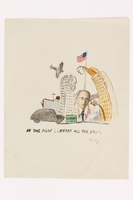
Child's collage of a man's face over New York City by a German Jewish refugee
Object
Collage of his arrival in America created by Fritz Vendig, 13, after leaving Switerland for America with his parents, Ernst and Charlotte, and younger brother Heiner. In the mid-1930s, Ernst's business was taken from him when it was Aryanized, or cleansed of Jews. In November 1938, Ernst was arrested during Kristallnacht. After his release, they prepared to leave. On May 13, 1939, the family, along with Ernst's mother Pauline, sailed for Cuba on the MS St. Louis. Cuban authorities refused entry to nearly all passengers. Appeals were made to the Cuban and US governments, but the ship had to return to Europe. The family was given refuge in Belgium. In May 1940, Germany occupied Belgium and Ernst was deported to France and imprisoned in St. Cyprien and then Gurs internment camps. In 1941, Charlotte, the boys, and Pauline obtained false papers and illegally entered France to be near Ernst. In August 1942, they were all interned at Les Milles and then Rivesaltes, until Charlotte's sister in Switzerland managed to get them out of the camp and smuggled into Zurich. The war ended in May 1945 with Germany's surrender. Fritz (later Fred) and his family emigrated to the United States in 1946.
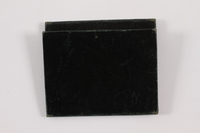
Black leather photo wallet used by a young German Jewish refugee
Object
Small wallet with three photo windows used by Fritz Vendig or a family member after leaving Nazi Germany in 1939. In the mid-1930s, Fritz's father's business was taken from him when it was Aryanized, or cleansed of Jews. In November 1938, Ernst was arrested during Kristallnacht. After his release, the family prepared to leave. On May 13, 1939, Fritz, 7, his parents Ernst and Charlotte, his brother Heiner, 2, and his paternal grandmother Pauline, sailed for Cuba on the MS St. Louis. Cuban authorities refused entry to nearly all passengers. Appeals were made to the Cuban and US governments, but the ship had to return to Europe. The family was given refuge in Belgium. In May 1940, Germany occupied Belgium and Ernst was deported to France and imprisoned in St. Cyprien and then Gurs internment camps. In 1941, Charlotte, the boys, and Pauline obtained false papers and illegally entered France to be near Ernst. In August 1942, they were all interned at Les Milles and then Rivesaltes, until Charlotte's sister in Switzerland managed to get them out and smuggled into Zurich. The war ended in May 1945 with Germany's surrender. Fritz (later Fred) and his family emigrated to the United States in 1946.
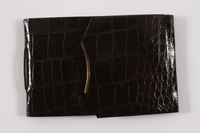
Faux alligator photo wallet used by a young German Jewish refugee
Object
Small imitation alligator wallet with 9 photo inserts used by Fritz Vendig or a family member after leaving Nazi Germany in 1939. It carried photographs now part of 2013.486.1. In the mid-1930s, Fritz's father's business was taken from him when it was Aryanized, or cleansed of Jews. In November 1938, Ernst was arrested during Kristallnacht. After his release, the family prepared to leave. On May 13, 1939, Fritz, 7, his parents Ernst and Charlotte, his brother Heiner, 2, and his paternal grandmother Paulina, sailed for Cuba on the MS St. Louis. Cuban authorities refused entry to nearly all passengers. Appeals were made to the Cuban and US governments, but the ship had to return to Europe. The family was given refuge in Belgium. In May 1940, Germany occupied Belgium and Ernst was deported to France and imprisoned in St. Cyprien and then Gurs internment camps. In 1941, Charlotte, the boys, and Paulina obtained false papers and illegally entered France to be near Ernst. In August 1942, they were all interned at Les Milles and then Rivesaltes, until Charlotte's sister in Switzerland managed to get them out and smuggled into Zurich. The war ended in May 1945 with Germany's surrender. Fritz (later Fred) and his family emigrated to the United States in 1946.
Book written by the Captain of the MS St. Louis and owned by a passenger and German Jewish refugee
Object
Memoir covering the 1939 voyage of the MS St. Louis, written and signed by the captain of the ship, Gustav Schroeder, and owned by Fritz Vendig who was a passenger on the ship with his family. Fritz grew up in Germany with his parents, Ernst and Charlotte, his younger brother, Heiner, and his paternal grandmother, Pauline. In the mid-1930s, Ernst’s business was taken from him when it was aryanized, or cleansed of Jews. In November 1938, Ernst was arrested during Kristallnacht. After his release, the family prepared to leave, and on May 13, 1939, they set sail for Cuba on the St. Louis with over 900 other Jewish passengers fleeing Germany. Upon arrival, Cuban authorities refused entry to nearly all passengers. Appeals were made to the Cuban and United States governments, but the passengers could not disembark. Captain Schroeder refused to return to Germany before finding a safe haven for his Jewish passengers. The American Jewish Joint Distribution Committee reached an agreement with Belgium, Great Britain, France, and the Netherlands, where each country would take in a certain number of people. The Vendig family was given refuge in Belgium. In May 1940, Germany occupied Belgium and Ernst was deported to France. There, he was imprisoned in various internment camps. In 1941, Charlotte, the boys, and Pauline obtained false papers and entered France to be near Ernst. In August 1942, they were all interned at Les Milles and then Rivesaltes, until Charlotte’s sister in Switzerland managed to get them out and smuggled into Zurich. Fritz and his family immigrated to the United States in 1946.



